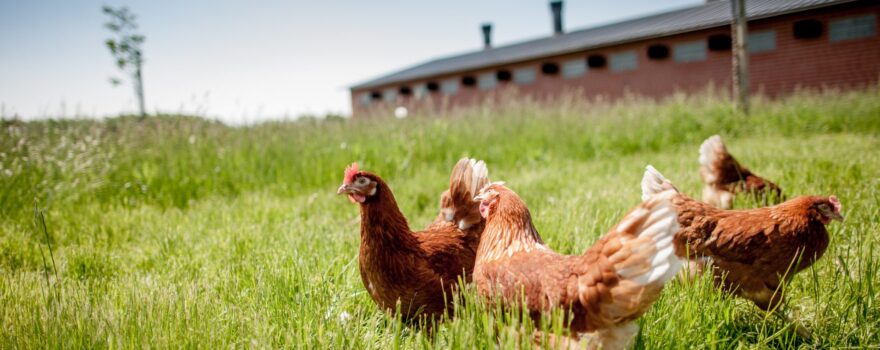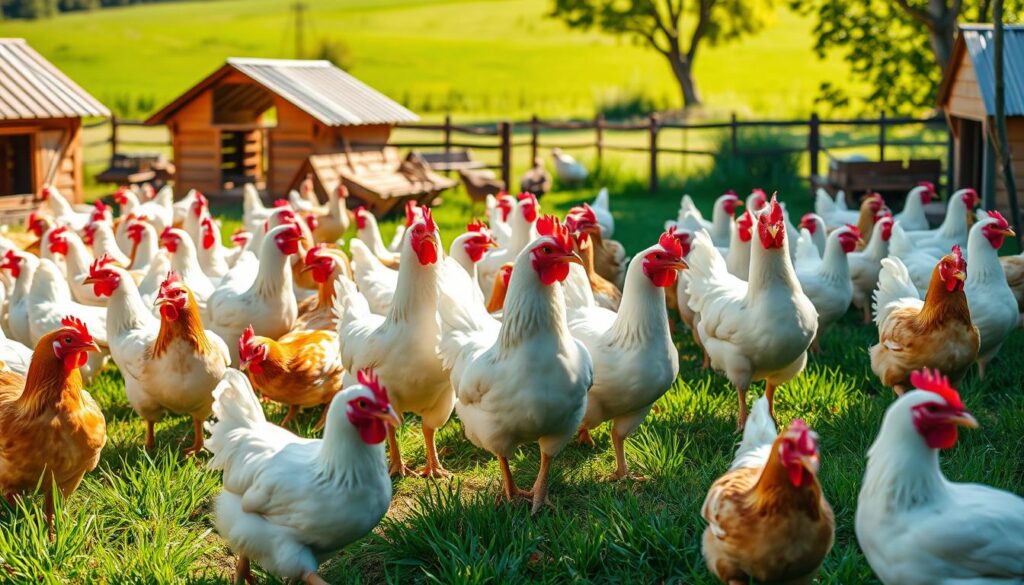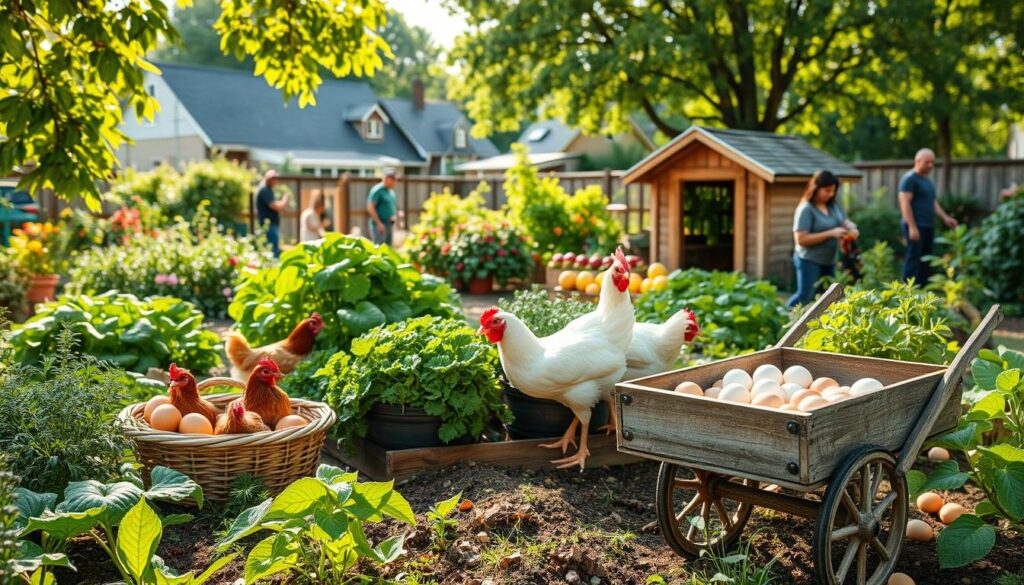
In many low-income areas, getting enough nutritious food is hard. Broiler chickens are a key solution because they are cheap and full of protein. As the world’s population grows, finding affordable, high-quality protein is more important than ever. Broiler chickens are efficient at turning feed into meat, making them a great answer to this problem.
Key Takeaways
- Broiler chickens provide a readily available and affordable source of protein for low-income communities.
- Efficient feed-to-meat conversion makes broiler chicken production cost-effective and sustainable.
- Broiler chicken farming can create employment opportunities and support rural economic development.
- Incorporating broiler chickens into local food systems can improve nutrition security and dietary diversity.
- Addressing challenges such as biosecurity and disease control is crucial for the long-term viability of broiler chicken production.
Broiler Chickens as a Source of Affordable Protein for Low-Income Regions
Broiler chickens are a great source of affordable protein for low-income areas worldwide. They grow fast and use less food, making them a reliable and cheap protein option. This is especially important for communities facing food shortages and malnutrition.
Broiler chickens are good because they produce a lot of meat quickly. This is great for low-income families who can’t afford more expensive meats like beef or pork. They also need less land, water, and food than other animals, making them a better choice for areas with limited resources.
| Protein Source | Protein Content (per 100g) | Cost per Serving |
|---|---|---|
| Broiler Chicken | 31g | $0.50 – $1.50 |
| Beef | 26g | $2.00 – $5.00 |
| Pork | 27g | $1.50 – $3.00 |
The table shows that broiler chickens have more protein and cost less than other meats. This makes them a better choice for people in low-income areas. It helps fight protein deficiency and improve nutrition in these communities.
Also, farming broiler chickens can help local economies by creating jobs. This supports the well-being and economic growth of families in these areas.
As the need for affordable protein grows, broiler chickens are a smart and sustainable choice. They help meet the nutritional needs of low-income people. By using these birds’ benefits, we can improve food security and help communities become healthier and more resilient.
The Rising Demand for Affordable Protein
As the world’s population grows, the need for affordable protein sources is more urgent than ever. Many low-income communities struggle to ensure food security and meet their nutritional needs, especially for protein. Broiler chickens offer a nutritious and affordable protein solution for these communities.
Global Challenges in Food Security
The Food and Agriculture Organization (FAO) reports that 2 billion people face food insecurity. They lack access to safe, nutritious, and enough food. This problem is worse in developing areas, where protein deficiency can lead to health problems like stunted growth and weakened immune systems.
Nutritional Deficiencies in Low-Income Communities
In low-income communities, protein deficiency is a big issue. It causes nutritional deficiencies that harm health and well-being. Affordable protein sources, like broiler chickens, are key to solving this problem and improving nutrition in these areas.
| Indicator | Global Average | Low-Income Countries |
|---|---|---|
| Protein Deficiency | 8.9% | 15.2% |
| Stunting in Children | 21.9% | 33.1% |
| Wasting in Children | 6.9% | 9.5% |
The data shows a big gap in protein deficiency and nutrition between the world average and low-income countries. It highlights the urgent need for affordable and accessible protein in these areas.
Understanding Broiler Chicken Production
Broiler chicken production is key in the poultry farming world. It helps make protein affordable for those who need it most. This process includes raising chickens for meat, from hatching to processing. Learning about broiler chicken production shows how it can fight protein shortages. It also supports livestock production and poultry farming in a sustainable way.
The journey starts with hatching chicks. This stage needs careful watching and the right environment for a good start. After hatching, chicks get top-notch commercial feeds and fresh water. This ensures they get the nutrients they need.
Creating a safe and comfy home for the birds is crucial. The temperature, air flow, and biosecurity are all watched closely. This helps keep the birds healthy and happy.
| Broiler Chicken Production Stages | Key Considerations |
|---|---|
| Hatching | Optimal environmental conditions, chick health monitoring |
| Feeding | High-quality commercial feeds, fresh water supply |
| Housing | Temperature, ventilation, biosecurity measures |
| Processing | Efficient and humane slaughtering, meat quality control |
The last step is processing the birds. They are slaughtered humanely and their meat is checked for quality and safety. This detailed approach to broiler chicken production is vital. It helps make sustainable agriculture a reality and meets the need for affordable protein.
“Broiler chicken production is a vital component of the poultry farming industry, playing a crucial role in providing affordable protein to low-income regions.”
By grasping the different stages and best practices of broiler chicken production, we can open up new chances. These chances help improve food security and nutrition in areas that need it most. This leads to a fairer and more sustainable food system for everyone.
Economic Benefits of Broiler Chickens
Broiler chickens are a key source of meat for many. They are raised specifically for this purpose. Their quick growth and efficient use of feed make them a cost-effective choice for low-income families.
Cost-Effective Meat Production
Broiler chickens are known for turning feed into meat quickly and efficiently. This means farmers can produce meat at a lower cost. This is great for families who are on a tight budget.
Job Creation in Rural Areas
The broiler chicken industry also creates jobs, especially in rural areas. Farms and processing facilities offer stable work. This helps the local economy and improves life in rural areas.
| Economic Benefit | Impact |
|---|---|
| Cost-Effective Meat Production | Broiler chickens’ efficient feed conversion and rapid growth enable lower production costs, making the meat more affordable for low-income families. |
| Job Creation in Rural Areas | Broiler chicken farms and processing facilities provide employment opportunities, supporting the economic development of rural communities. |

“The broiler chicken industry has been a game-changer in providing affordable and accessible protein to communities that struggle with food insecurity.”
Nutritional Value of Broiler Chicken Meat
Broiler chicken meat is packed with nutrients, especially high-quality protein. This protein is vital for our health. It has all the amino acids our bodies need.
Protein Content and Quality
Broiler chicken meat is a top-notch protein source. It has about 20-25 grams of protein per 100 grams of cooked meat. This protein is of the highest quality, with all essential amino acids in the right amounts.
- The protein in broiler chicken meat is considered a “complete” protein, as it provides the full range of amino acids required by the human body.
- Broiler chicken meat is also a rich source of other essential nutrients, including B vitamins, iron, and zinc, further enhancing its nutritional value.
- The high-quality protein and nutrient profile of broiler chicken meat make it a valuable addition to the diets of individuals in low-income regions, helping to address issues of protein deficiency and malnutrition.
Adding broiler chicken meat to diets can be a budget-friendly way to boost nutrition. It supports healthy growth and development.
“Broiler chicken meat is a remarkable source of high-quality protein, providing the essential nutrients needed to support healthy individuals and communities.”
Sustainable Broiler Chicken Farming Practices
Sustainable broiler chicken farming is key to reducing the harm done by livestock. It helps make sure everyone can afford protein. Farmers use smart ways to use resources, manage waste, and use green tech. This way, they raise chickens that help the planet and support Sustainable Agriculture and Livestock Production.
Choosing the right chicken breed is important. Breeds that fit the local weather and need less help are better. Also, good homes and air systems for chickens cut down on waste and keep them healthy.
- Using the right food for chickens is also crucial. Local, nutrient-rich feed cuts down on carbon and helps the local economy.
- Handling manure well, like through composting or biogas, turns waste into useful stuff. This boosts the farm’s Sustainable Agriculture efforts.
By using these green farming ways, farmers can lessen their environmental harm. They also make sure this affordable protein stays available for those who need it most.
“Sustainable broiler chicken farming practices are essential in ensuring the long-term availability of affordable protein for all.” – Dr. Sarah Wilkins, Sustainable Agriculture Expert
Challenges and Limitations
Broiler chickens are a cheap way to get protein. But, there are challenges and limits to consider. Keeping the chickens healthy and safe is key. This helps both the chickens and the people who eat them.
Biosecurity and Disease Control
Disease is a big problem in broiler chicken farming. Diseases like avian influenza can spread fast. This can cause big losses and make it hard to get protein.
To fight this, farms must follow strict biosecurity rules. This includes keeping the place clean, isolating sick birds, and training workers. It’s all about keeping the chickens safe.
- Strong disease control is vital. This means checking the health of the birds often, vaccinating them, and treating sick ones quickly.
- Teaching farmers how to keep their farms clean helps a lot. Giving them the right tools and info is important too.
- Working with vets and health experts is key. They help keep up with new threats and find ways to fight them.
By facing these challenges, the broiler chicken industry can keep providing cheap protein. This helps low-income families get the food they need, improving their health and well-being.
| Challenge | Impact | Potential Solutions |
|---|---|---|
| Disease Outbreaks | Significant losses in flock, disruption in protein supply | Robust biosecurity protocols, disease monitoring and management |
| Feed and Water Availability | Fluctuations in production costs and supply | Diversifying feed sources, improving water management systems |
| Environmental Impacts | Potential pollution, resource depletion | Sustainable farming practices, waste management, and recycling |
Integrating Broiler Chickens into Local Food Systems
Broiler chickens are key in making food more affordable and nutritious. They help strengthen local food systems, especially in low-income areas. To make this work, we need to improve supply chains, distribution, and partnerships between farmers and local groups.
Setting up reliable supply chains is important. These chains connect farmers to markets and communities nearby. This way, we can cut down on costs, reduce waste, and make chicken meat more affordable and available.
Broiler chickens also help create jobs and boost rural economies. Farms and processing plants in these areas offer jobs and income. This helps improve nutrition security and well-being in the community.
Working together is crucial. Producers, community groups, and local governments need to team up. They can help build distribution networks, ensure fair prices, and share the health benefits of broiler chickens.

By adding broiler chickens to local food systems, we can make food more accessible. This improves nutrition security and health in communities. It’s a big step towards solving global food security issues and making sure everyone has access to good protein.
Cultural Acceptance and Dietary Preferences
Using broiler chickens as a cheap protein in poor areas needs to understand local culture and food likes. Overcoming old barriers and fitting into local food ways is key. This makes sure broiler chickens stay a good protein choice for a long time.
In many places, eating chicken is a big part of tradition and faith. Broiler chickens grow fast and use less food, but they might not fit with some cultural or food rules. It’s very important to think about these things to help people in poor areas accept and use broiler chickens more.
Also, what people like to eat is very important for making broiler chickens work in these areas. Making broiler chicken meat in ways that locals are used to can make it more appealing. This can help more people accept it.
“Integrating broiler chickens as a sustainable protein source in low-income regions must consider the cultural and traditional nuances of the local community.”
By looking at and fixing these cultural and food issues, broiler chickens can be seen as a good and wanted protein option. It fits with what people in poor areas like and do, helping to make food more secure and nutritious.
Policy Initiatives and Government Support
Governments worldwide see the value of broiler chickens in solving nutrition security and food accessibility problems in poor areas. They’ve launched policy initiatives and government support to help broiler chickens become part of local food systems.
One key effort is offering subsidies and financial help to broiler chicken farmers. These aids reduce production costs, making broiler chicken meat cheaper for locals. Governments also build hatcheries, feed mills, and processing plants to boost production efficiency and access.
Moreover, governments have made it easier to include broiler chickens in school meals and social programs. This makes broiler chicken meat available to those who need it most, enhancing nutrition security and food accessibility.
But it’s not just about money. Governments also set rules to ensure broiler chicken products are safe and of good quality. They enforce biosecurity, disease control, and quality checks to keep the broiler chicken supply chain strong.
The mix of policy initiatives and government support has helped make broiler chickens a more affordable protein source. This effort has greatly improved nutrition security and food accessibility in low-income areas.
Success Stories and Case Studies
Broiler chickens are a key solution for affordable protein in low-income areas. Real success stories and case studies show how they improve local food systems. They offer insights into how broiler chickens can make a big difference.
In rural Kenya, a small farming community saw a big change. They started raising broiler chickens to fight food insecurity and malnutrition. By working together, they could afford to raise chickens efficiently. This led to a steady supply of protein at a low cost.
“Broiler chickens have been a game-changer for our community. We can now provide our children with the nutrition they need to thrive, all while generating a sustainable income for our families.”- Jane Mwangi, a local farmer in Kenya
In Peru’s Andean region, a non-profit helped indigenous communities start broiler chicken farms. They got training, resources, and market connections. This helped them meet their protein needs and even sell extra, boosting their economy and food security.
- Increased access to affordable, nutrient-dense protein for low-income households
- Job creation and income generation for small-scale farmers
- Empowerment of women and marginalized communities through cooperative models
- Positive ripple effects on community health and well-being
These stories show how broiler chickens can change lives in low-income areas. They offer a way to get essential protein and build stronger local food systems. Communities worldwide are finding new ways to access protein and improve their health.
Future Prospects and Innovations
The demand for affordable protein is rising fast. This is good news for broiler chickens in low-income areas. New technologies like advanced breeding and precision farming will make chicken production better and more sustainable. This means more people can afford nutritious meat.
Using sustainable farming methods is also key. This includes renewable energy and turning waste into energy. These steps help farmers in low-income areas. They make chicken more affordable and reduce harm to the environment, creating a better food system.
Improving how chicken gets to people is another important step. Better distribution and marketing can help. Digital tools and new market channels can make chicken products more accessible. This helps low-income communities get the nutrition they need, improving health and well-being.